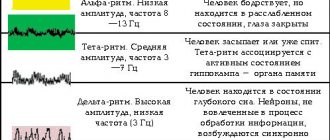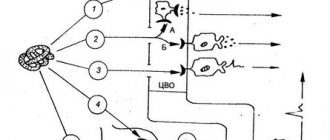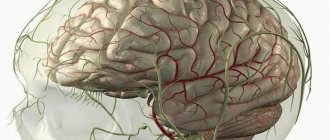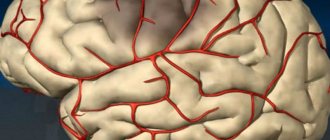Serotonin molecule
The pineal gland (pineal gland) is a tiny cerebral process that belongs to the central endocrine system.
The main hormones of the pineal gland are serotonin and melatonin. These active substances play a leading role in regulating a person’s circadian rhythms and restoring the body during sleep. They also affect the function of the pituitary gland, thyroid gland, adrenal glands, gonads, pancreas (insulin production), nervous system function and emotional state.
The other two hormones are less well known. Adrenoglomerulotropin regulates kidney function, and dimethyltryptamine (DMT) regulates the emotional and mental sphere.
Serotonin
The main regulator of sleep and wakefulness processes. It is produced only during daylight hours under the influence of ultraviolet radiation. Refers to neurotransmitters and tissue hormones. This means that it is involved in the conduction of nerve impulses, but also “works” in tissues and organs.
The mechanism of action of serotonin
Serotonin as a neurotransmitter
It is sometimes called the hormone of joy, but this is not entirely true. Dopamine is largely responsible for the emotions of joy, while serotonin rather suppresses the center of negative emotions, preventing the development of depression.
In addition, it reduces sensitivity to pain. People with a high pain threshold have fairly high levels of serotonin and many serotonin receptors.
It has an inhibitory effect on the nervous system - this is due to its anti-stress and general calming effect.
Serotonin is important for blocking weak sensory signals so that the mind does not “hear” distracting sounds, and a person can focus on tasks that are important to him.
Together with dopamine, serotonin is involved in the regulation of the hypothalamic-pituitary system, stimulating the production of prolactin and other pituitary hormones.
Serotonin as a tissue hormone
The tissues contain a large amount of serotonin and receptors for it. It affects blood vessels, the digestive system, smooth muscles, and immunity.
Serotonin constricts blood vessels and thickens the blood if you need to quickly stop bleeding and form a blood clot. It also plays a big role in the formation of allergic and inflammatory reactions - it increases vascular permeability, stimulates the movement of leukocytes to the site of inflammation, and increases the level of eosinophils in the blood.
Serotonin contracts smooth muscles, enhancing intestinal motility, participates in the metabolism of lactobacilli, improves digestive processes, and also causes uterine contractions during childbirth.
Interesting! The pineal gland synthesizes 5–10% of the total amount of serotonin, the rest is produced by the intestines.
Functions of pineal gland hormones
Melatonin
Melatonin is the main hormone synthesized by the pineal gland. Its main function is to regulate the body’s circadian rhythm (sleep-wake). This occurs due to the wave-like release of melatonin, with the peak concentration of this substance in the blood occurring between 1 and 5 am. Melatonin synthesis depends on the level of light: the less light, the more it is produced.
Apart from this, there are a number of other functions of melatonin:
- Decreased body activity (physical, mental, emotional).
- Pressure regulation.
- Reduced growth rate of the child.
- Regulation of seasonal processes in animals (migration, hibernation, molting, storage of substances for the winter).
- Increased activity of immune system cells.
- Reduced calcium intake from the blood into bone tissue.
- Reducing the rate of aging of the body.
- Antioxidant action.
This hormone actually has many actions, which determines its necessity for the normal functioning of the whole organism.
Adrenoglomerulotropin
Many authors do not distinguish adrenoglomerulotropin as an independent hormone, since in fact it is melatonin, which has undergone a number of chemical changes. However, for the sake of completeness, let’s consider his role. Adrenoglomerulotropin increases the release of aldosterone in the glomeruli of the adrenal cortex. Due to the action of aldosterone, water retention in the body occurs, the loss of sodium and chlorine ions decreases, and the release of potassium and hydrogen increases. As a result, there is an increase in circulating blood volume and an increase in blood pressure.
Serotonin
Serotonin has a dual role in the body.
On the one hand, it acts as a neurotransmitter, ensuring rapid transmission of impulses in some parts of the nervous system (brain stem, spinal cord, cerebellum, limbic system). This determines the participation of serotonin in such important areas of activity as spatial orientation, emotional state, the functioning of basic reflexes and the maintenance of vital functions (control of blood pressure, heart rate, respiratory rate).
On the other hand, due to the release of serotonin into the blood, it can act as a hormone, acting on target organs. Its effects in this ampoule will be as follows:
- Increased secretion of substance P (indirect effect on blood pressure, enhanced action of immune cells, activation of digestive processes).
- Regulation of vascular lumen.
- Stimulation of prolactin secretion (indirect effect on increasing milk production in the mammary glands).
- Increased blood clotting.
- Stimulation of digestive processes.
- Increase in pleasant, positive emotions (“happiness hormone”).
Just like the formation of melatonin, the synthesis of serotonin requires sunlight.
Histamine
Histamine can be released in different places in the body: it is formed in the pineal gland, contained in mast cells (histiocytes), which are found in almost all parts of the body (intestines, bronchi, lungs, skin).
This hormone has quite a lot of actions, we will try to list the main ones:
- Reduction of bronchial lumen.
- Reducing the diameter of blood vessels.
- Stimulation of the pituitary gland (indirect effect on the release of tropic hormones (ACTH, TSH, STH, LTG), vasopressin, oxytocin).
- Increased formation of gastric juice.
- Increased release of certain nervous system mediators (GABA, acetylcholine, norepinephrine, serotonin).
- Increased blood pressure and heart rate.
It is worth noting that one of the main meanings of histamine is its participation in allergic reactions. That is why many of its effects help remove foreign elements (allergens) from the body.
Norepinephrine
Norepinephrine is one of the main mediators of the sympathetic nervous system. Due to this, it has the following effects:
- Reducing the lumen of blood vessels.
- Increased frequency and strength of heart contractions.
- Increased blood pressure.
- Promotes the release of glucose from tissues into the blood.
- Increases the lumen of the bronchi.
In addition, adrenaline stimulates the transmission of nerve impulses to the central nervous system, resulting in an improvement in cognitive functions (thinking, memory, reaction speed).
Conclusion
The secretion of all pineal gland hormones depends on many factors, the main one of which is the level of light. In addition, physical activity, the quality and quantity of food consumed, and the use of medications are important.
Also, all hormones of the pineal gland are modified amino acids in their structure, so for their synthesis it is necessary to satisfy the body's need for protein foods.
For convenience, below is a table of the main hormones of the pineal gland and their functions.
The main hormones of the pineal gland and their functions
| Hormone | Function |
| Melatonin |
|
| Adrenoglomerulotropin |
|
| Serotonin |
|
| Histamine |
|
| Norepinephrine |
|
Disorders of the pineal gland
Disorders of the function of the pineal gland are often associated with tumor processes - pinealomas. In this case, its hyperfunction or hypofunction may develop - an increase or decrease in hormone production. Failure in the synthesis of pineal gland hormones leads to obesity, hypothyroidism, diabetes, and other endocrine disorders.
Pinealomas are common in childhood, especially in boys. Hyperfunction of the gland leads to underdevelopment of the genital organs in children, and hypofunction, on the contrary, leads to early puberty.
Tumors require surgical removal, and malignant tumors require additional radiotherapy and chemotherapy.
Functional hypofunction of the pineal gland. It often occurs in older people and is one of the most common causes of sleep disturbance (insomnia). With this pathology, the organ itself does not have organic lesions, but its function is reduced, and patients suffer from irritability, anxiety, increased fatigue, memory loss, a tendency to colds, and hormonal disorders.
Desynchronoses. These conditions are characterized by an imbalance in the melatonin production cycle. They develop when the usual routine changes, as well as with somatic and mental illnesses. Severe illnesses can lead to a complete absence of diurnal changes in melatonin levels.
Desynchronosis is also called "pilot's disease"
External desynchronosis, caused by a rapid change in time zone when flying to another hemisphere, does not require treatment, but time for adaptation.
Internal desynchronoses caused by long-term violations of the daily routine and illnesses lead to a disorder of the body's adaptability, the development of acute and exacerbation of chronic diseases, and nervous disorders.
Classification of pineal tumors
- pineocytoma (pinealocytoma) is a slow-growing tumor that consists of mature pinealocytes. It is observed in approximately 45% of patients with tumors of the pineal gland. Develops at the age of 25-30 years equally often in men and women.
- pineoblastoma is a high-grade tumor, an embryonic tumor with poor differentiation, which has many common features with medulloblastoma. Accounts for about 45% of all pineal gland tumors. Has a tendency to metastasis. It is detected mainly in adolescence (childhood), although it is very rare in adults.
- Tumor of the pineal gland parenchyma is characterized by the least predictable course. They are more often observed in adults and account for only 10% of all tumors of the pineal gland.
How to normalize the functioning of the pineal gland
Peptide bioregulators will help restore normal activity of the pineal gland during functional hypofunction and desynchronosis. The drug Endoluten is designed specifically to correct the function of the pineal gland, and contains its peptide complex A-8.
As a result of taking Endoluten, the functioning of the entire neuroendocrine system is normalized: circadian rhythms are restored, the immune system is strengthened and the body is rejuvenated.
Regulation of functioning
It is worth noting that the features of the work and regulation of the pineal gland have not yet been studied enough. Research is difficult due to the small size of the gland and its location. However, it has been proven that the pineal gland is controlled not only by nerve endings, but is also receptive to light.
Of course, light does not penetrate directly to the pineal gland. However, photons stimulate specific ganglion cells in the retina. From here, the nerve impulse is transmitted to the suprachiasmatic nucleus of the hypothalamus, from where it is sent through the paraventricular nucleus to the upper segments of the thoracic spinal cord. From here, excitation is transmitted to the pineal gland through the superior cervical ganglion. It is worth noting that the impulse arising in the suprachiasmatic nucleus does not stimulate, but, on the contrary, inhibits the functioning of the pineal gland. Thus, in light, melatonin secretion decreases, and in darkness (at night) it increases. As for the stimulation of the pineal gland, the neurotransmitter in this case is norepinephrine.
How to use Endoluten?
It is important to understand two key points:
- The pineal gland is very small in size. Its mass is only 1 g;
- Accordingly, even one capsule of Endoluten per day is too much.
Therefore, taking two or more capsules per day will simply create an extra burden on our body and lead to a waste of money. The most effective scheme for using Endoluten is to take 1 capsule every 2 days for a month. This course should be taken every six months. This approach guarantees maximum effect and provides the opportunity to save an impressive amount of money.
Pineal gland in modern esotericism
It's no secret that a lot of mystical stories and esoteric theories are associated with the pineal gland. The fact is that this organ was discovered relatively late, and hidden deep in the brain structures, which prompted some scientists and philosophers to think about the extreme importance of the pineal gland. For example, Rene Descartes in his works called the pineal gland “the saddle of the soul.” And indeed, it was this structure that for decades and even centuries was perceived as a kind of container for the human soul.
There are also more ancient beliefs about the mystical “third eye,” which allows a person to see the invisible and is responsible for various extrasensory abilities. For example, in the 19th century, a theory was put forward that a mysterious third eye actually exists. But if in some animals it is located on the surface of the body (for example, in some cyclostomes the pineal gland actually comes to the surface and serves as a photosensor), then in people the eye “hides” inside the skull.
Pineal gland diseases
Of course, some diseases can also affect this part of the brain. For example, often during examinations various neoplasms are discovered in a structure called the pineal gland. What it is? Yes, sometimes malignant degeneration of cells occurs in the tissues of the pineal gland. A benign tumor or cyst appears.
Since the pineal gland is an endocrine gland, naturally the hormones it produces affect the functioning of the entire endocrine system. Even a small epiphysis cyst can lead to severe hormonal imbalance and the development of a disease called macrogenitosomia. This disease is accompanied by changes in the level of certain hormones, which entails premature physical and sexual development (the appearance of menstruation at an early age, etc.). Mental retardation is often observed.
Let's consider the operating principle of Khavinson peptides
Peptides are small chains of amino acids that are linked by amide bonds. Peptides can be called building materials for proteins, thanks to which all metabolic processes and reactions take place in the human body. The basis of any of our cells is a DNA molecule containing data about everything that concerns the human body, from life expectancy to eye color. DNA “understands” that various viruses and free radicals want to destroy it. Therefore, it is in a closed format. There is only one unique key that can unlock DNA and trigger protein production. This key is peptides.
If the level of peptides in the body is low, then there is simply no one to direct the functioning of the body. As a result, a large number of failures occur. A clear example for comparison would be the movement of a vehicle without a driver. Just imagine that it is in the DNA of most people to live more than 100 years. However, the average life expectancy is only 70 years. Peptide biological regulators help to fully realize the data that is recorded in our genes, reducing the gap between the intended and actual life expectancy. Of course, in the conditions of a modern metropolis with a terrible environment, it is extremely difficult to live more than 100 years, but almost everyone can live to be 85-90 years old.
Where is the pineal gland located? Location of the gland
The superior cerebral appendage is located at the bottom of the third cerebral ventricle. In the oblong depression between the upper colliculi of the quadrigeminal, where the epiphysis is located, leads come from the pineal gland that attach it to the visual tuberosities.
Thus, one side of the epiphysis is located in the region of the midbrain, and the other is adjacent to the third ventricle. In simple terms, the pineal gland is a type of gland located between the hemispheres of the brain. The volume of the gland in an adult is from 25 to 430 mg, while the mass of the pineal gland depends on many factors: the person’s age, his state of health, gender, environmental conditions and climate (the average is 0.2 grams).
7.2. Avulsion of the epiphysis of the femoral head
Avulsion of the epiphysis of the femoral head is often combined with necrosis of the femoral head. In this case, the epiphyseal line expands and takes a disordered position, the connection of the epiphysis with the metaphysis becomes unstable and, under the influence of external force, the epiphysis is torn off, which is divided into the following stages: prophase of avulsion, avulsion stage, mild, moderate and severe avulsion and consequences of avulsion.
Complications in the prophase of this disease occur in the form of ischemic necrosis of the femoral head - the cartilage dissolves, and necrosis of the head provokes separation of the epiphysis. Acute avulsion of the epiphysis most easily occurs with ischemic necrosis of the femoral head. Manual reduction and fixation, internal fixation with steel needles can increase necrotic changes in the head. Of all the methods and techniques used for the treatment of aseptic necrosis, the probability of tearing off the epiphysis of the femoral head during plaster fixation and penetration of the femoral head with steel needles is the highest.










